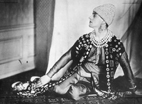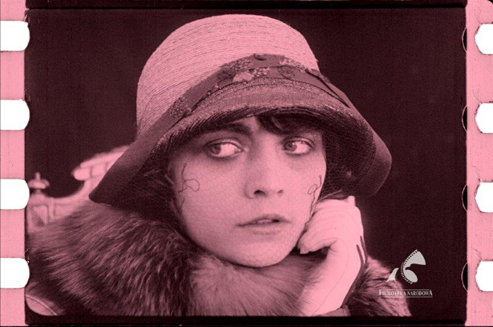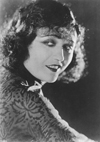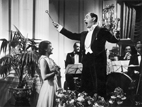Pola Negri, Jan Kiepura, Anoni Cierplikowski and Sara Lipska – Polish immigrants, who set the tone in the pre-war world of theater, opera and fashion, will triumph again on May 2, in Gdynia. The Emigration Museum once again celebrates the Day of Polonia and Poles abroad, and on this occasion they prepared cultural and educational events under the banner ‘Poland makes chic!’. In the program there will be workshops, presentations and special events. As the grand finale, the extraordinary silent film with Pola Negri – “Mania – History of a cigarette factory worker ” will be accompanied by a live concert. This unique, open-air symphonic concert of Wrocław Chamber Orchestra Leopoldinum, under the direction of maestro Jerzy Maksymiuk, will perform for everyone who will be on May 2, 2013 in Gdynia.
As part of the ‘Polish makes chic!’, the Emigration Museum in Gdynia presents the profiles of Polish immigrants who in an unconventional way earned approval and recognition in the 20’s and 30’s. and began their international careers in film, visual arts, design, fashion and music. Legendary and shrouded in mystery, the undisputed star of silent cinema Pola Negri, the “king of tenors”, Jan Kiepura, the outstanding visual artist and designer Sara Lipska, and the great creator and hair stylist Antoni Cierplikowski will be in the spotlight.
Through work that mixed popular culture with fine art, the Emigration Museum is pleased to present the Polish emigrants to promote the idea of a modern world open to patriotism.
THE FILM SCREENING WITH CONCERT
“Mania – History of a cigarette factory worker”
Wrocław Chamber Orchestra Leopoldinum, conducted by Jerzy Maksymiuk
Lecture before the film by prof. Tadeusz Kowalski, director of the National Film Archive.
Grunwald Square at the Musical Theatre | Gdynia | ul. Armii Krajowej | at 9.00 p.m.
“Mania – History of a cigarette factory worker” under the Polish Presidency was shot in ten European capitals – Berlin, Brussels, Kiev, London, Madrid, Minsk, Moscow, Paris, Beijing, Tokyo. This archival film from 1918 with Pola Negri in the leading role, was considered to be irretrievably lost for many years. Then it turned out that the only copy was preserved in the collection of a Czech film collector, which the National Film Archive bought in 2006. After the refurbishing, “Mania” could return to the screen after nearly a century. The new soundtrack was composed by the eminent Polish composer and conductor Jerzy Maksymiuk. The project of the National Film Archive was first presented in Gdynia, in the outdoor setting of Grunwald Square.
“Mania. Die Geschichte einer Zigarettenarbeiterin “, dir. Eugen Illés, Germany, 1918, 85 min
Cast: Pola Negri, Werner Hollmann, Arthur Schroder, Ernst Wendt
“Mania” is one of the first films of Pola Negri, who starred in it as a mid-twenties girl. She charmed with her original beauty, agility of the body, facial expressions, and exceptional personality. Artistic merits of the film include rough dramaturgy, interesting performances, interesting and sophisticated operating means, and a scenography designed by Paul Leni, a known expressionist film director.
POLA NEGRI (1897-1987)
The great movie star was born in the village of Lipno, as Barbara Apolonia Chałupiec. Exotic beauty, charisma and rich facial expressions meant that the roles sank deep into the mind of viewers. She created the form of a femme fatale – a woman-vamp, and became a huge idol of the big screen. In the history of cinema, she’s been the first European, and actually the only Polish actor who made a real career in Hollywood. She began her career performing in Poland and Germany, and soon became known as an extremely talented actress. In Berlin, under the guidance of master Ernst Lubitsch, she reached her peak of popularity. During that period her most important achievements came in films such as “Carmen” (1918), “Madame Dubarry” (1919), and the film adaptation of “Sumurun” (1920). News about her talent attracted the attention of American movie producers, and in1923 Pola Negri was triumphantly entering Hollywood. She was the one object of desire – she had been dating Charlie Chaplin, was a fiancee of Rudolph Valentino, and thanks to the marriage with Georgian Sergei Mdivanii, became a duchess. She played the role of exotic dancers in “Mans” (1924) and “Spanish dancer” (1923), and a girl from the underworld in “Black Lu” (1924), before she had an unforgettable performance in the film “Hotel Imperial” (1927), by Mauritz Stiller.
The arrival of sound in films made the Hollywood moved away from their current stars. Although the attempts of her voice were rather successful, Pola had a unique and expressive style of acting. She returned to Europe, and even Germany turned out to be a difficult place for her to work, where her two major roles were in the films “Moscow-Shanghai” (1936) and “Tango Notturno” (1937). Before the outbreak of WWII, she returned to the United States, and a few years later she appeared in the comedy “Hi Diddle Diddle” (1943), before her last big screen performance in “Księżycowe prządki” (1964).
At the time of her death, she was a silent movie legend. She’d appeared in over sixty films, where she’d created a unique style of acting based on a combination of mimic talent and dance. She was friends with the biggest names of her era, including Albert Einstein, and received love and praise from all the major big screen Hollywood lovers. Often emphasising the strong emotional ties with Poland, she once said “I have never stopped feeling Polish, and I have always emphasised my Polish descent.” / National Film Archive/
WORKSHOPS – DESIGN THE FASHION! | Workshops to create fashion in the style of the 20’s/30’s.
Become a tomboy! – Hair styling show à la Cierplikowski
What’s going on in a silent movie? – Workshops to create sounds for the film
Polish Bank | Gdynia | ul. 3 Maja 25 | 12.00-6.00 p.m.
WORKSHOP – What’s going on in a silent movie? | Creating sounds for the films
Workshops and demonstrations thanks to which, we’ll know how sounds appear in silent films, especially when they are lacking in the movie. What an imitator of sounds do, what the synchronous effects are? Is it true that we can create the sounds manually? Did you know that creaking of snow can be a bag of potato flour, and bird wings flapping could be a made from construction gloves? Explore the magical world of objects that squeak, rattle, crackle, buzz and hum with us! Radoslaw Ochnio reveal some secrets of the noble profession of an imitator, which requires great precision and a bit of imagination and ingenuity. We invite children and youth to create sounds using both unusual and everyday items.
Radoslaw Ochnio is an experienced sound engineer who’s worked on many interesting film projects in recent years, both on set and in the studio (including “Virtual war”, “I am yours”). In addition, he teaches at the university ROE, and is also a frequent guest of specialised sound workshops.
Polish Bank | Gdynia | ul. 3 Maja 25 | 12.00-6.00 p.m.
WORKSHOP – Become a tomboy! | Hair styling show à la Cierplikowski
 Did you know that among the countless famous clients of Antoine’s, were Marlene Dietrich, Pola Negri, Joan Crawford and Greta Garbo? Would you like to feel like one of the stars of cinema in an unforgettable hairstyle of the 20’s and 30’s?
Did you know that among the countless famous clients of Antoine’s, were Marlene Dietrich, Pola Negri, Joan Crawford and Greta Garbo? Would you like to feel like one of the stars of cinema in an unforgettable hairstyle of the 20’s and 30’s?
Professionals in hair salon O’LA in Gdynia prepare the brave girls and women looking for styling demonstrations by archival photos from hairdos by Antoine de Paris. We invite all ladies to give themselves into the hands of stylists who will conjure an unusual hairstyle of a recent era. Become a tomboy á la Cierplikowski!
Polish Bank | Gdynia | ul. 3 Maja 25 | 12.00-6.00 p.m.
WORKSHOP – Design fashion! | Workshops to create fashion in the styles of the 20’s and 30’s.
Attractive workshops of design and liberated sewing activities in the fields of visual arts, fashion and styling. A unique opportunity to get to know both the creation of fashion, and to create your own design of clothing and accessories.
Participants will learn the characteristics of the 20’s and 30’s styled clothing with the creativity of Sara Lipska, and will design their own drawings inspired by fashion and art of the interwar period. The next stage of the course is to perform original designs on T-shirts, bags, or an addition to the clothing that will be available on site. It offers a full range of means of expression, like sprays, paints, felts, sewing and trimming accessories, all means by which to create their own crazy twentieth century fashion style.
The orkshops take into account the different levels of manual skills of the participants, so we invite children, as well as older youth and adolescents.
Conducted by: Monika Fuze & Magdalena Frąckiewicz
Polish Bank | Gdynia | ul. 3 Maja 25 | 12.00-6.00 p.m.
MUSIC ACTION OF THE CITY – Find Kiepura in Gdynia!
Did you know that Jan Kiepura performed in Gdynia in July 1939, causing widespread enthusiasm in the whole city? He made an unforgettable concert on Grunwald Square, where he sang songs from the roofs of cars, gathering crowds of faithful listeners. Inhabitants of Gdynia remembered his performances for many years.
The event “Find Kiepura in Gdynia”, evokes the atmosphere of that summer, when the arias and songs sung by the “king of tenors” resounded throughout the city. In a few unusual places in the center of Gdynia, we will once more hear the opera and operetta, songs and film songs, and music played at the turntables that take us to the golden age of the 20’s and 30’s. For the curious music lovers, we’ve prepared an urban game where the goal is to find as many vinyls containing the voice of Kiepura throughout every little crevice in the city centre, with prizes given to the winners by the Museum of Emigration.
JAN KIEPURA (1902-1966)
“The king of tenors” was the most popular actor and star of opera and operetta during the interwar. His career started with instant successes that brought him to recognition on Broadway, applauded by audiences of the Metropolitan Opera. He also appeared on the stages of Vienna, Milan, Berlin, Munich, Paris, Buenos Aires, Brussels, Havana, and Rio de Janeiro. As the lover on the screen, with a disarming smile and an amazing grace, he appeared in several films including “I sing for you” (1934), “I love all women” (1935), “The Charm of bohemian” (1937), and “Valse Brilliante” (1948). With his unique voice, irresistible charm, hard work and ability to interest, he gained huge popularity and great fortune. Jan Kiepura possessed a unique voice, great musicianship and an uninhibited self-esteem. He was epitomised bohemian ways, and was perhaps the first Polish cult artist in the purest sense of the word. As one of the first opera singers that could enter into dialogue with the audience, he was ahead of his time.
Jan Kiepura, despite the amazing career throughout his life, spoke of himself as a simple boy from Sosnowiec. He has never refused whenever asked to sing, and did so on the streets, from cab roofs, balconies or on the steps of opera houses.
He was a true citizen of the world, still a patriot. He demonstrated his Polish roots on many occasions, like stressing that he wears Polish shoes, attending Polish dinners, and hosting his wedding with Martha Eggerth in Poland.
Kiepura generously supported his family and friends, as well as young and talented artists, while often supporting charity concerts. While living permanently abroad he emphasised his ties with the country, and when he returned to Poland after the war, he adopted his motherland very enthusiastically. He died in Harrison, New York in 1966, but was – according to his will – buried in Warsaw ”Powązki”.
SPECIAL PROGRAM
SARA LIPSKA- POLISH ARTIST IN PARIS | lecture | at 3.00 p.m.
POLA NEGRI – THE LEGEND OF SILENT FILM | lecture | at 4.30 p.m.
HAND OF BARBER | screening | at 12.00, 1.00 p.m., 2.00 p.m., 3.00 p.m., 4.00 p.m., 5.00 p.m.
Polish Bank | Gdynia | ul. 3 Maja 25
SPECIAL PROGRAM
LECTURE | PRESENTATION | Sara Lipska – Polish artist in Paris
In the early twentieth century, Paris was the undisputed capital of artistic life. It was the prime destination of artists from all over the world, and one of the most important centres of Polish cultural life. Here, at the end of 1912, Sara Lipska arrived seeking new opportunities and creative freedom, and quickly joined the avant-garde circles of Russian ballets, and the Parisian theatre and fashion. She dealt with interior design for the likes of Helena Rubinstein and Antoine de Paris (Antoni Cierplikowski), among others, and in her boutique on the Champs Elysees, French actresses, singers and Russian aristocrats were getting dressed.
Leadership: Ewa Ziembińska, author of the first monographic elaboration of the creativity of Sara Lipska, devoted it to her show “Sara Lipska – In the shadow of the master “(Museum of Sculpture of Xawery Dunikowski in Królikarnia, 2012).
Polish Bank | Gdynia | ul. 3 Maja 25 | at 3.00 p.m.
SARA LIPSKA (1882-1973)
A versatile artist, she was the designer of the famous Russian ballets of Sergei Diaghilev and the avant-garde hairdresser and empress of beauty Helena Rubinstein. She was also the muse of sculptor Xawery Dunikowski, as well as the fashion and interior designer, theatre decorator, sculptor and painter Antoine de Paris (Antoni Cierplikowski). Furthermore, she was a recognised artist, awarded by gold medals at world exhibitions.
Most of her professional life was spent in Paris, where she emigrated in 1912. In France, she lived in the environment of the rich and powerful of Paris. She was close to the world of fashion, the theatre community, and artistic avant-garde.
After arriving in the French capital, she cooperated with Sergei Diaghilev and his Russian ballets which were highly successful, and she worked in the team of famous designer and costume designer Leon Bakst.
At the end of the 20’s, she designed the interiors of Antoine’s two Parisian apartments, including the famous maison de verre (glass house). For Helena Rubinstein, she designed the decor of her boutiques, shops, advertising banners, as well as bottles for perfume and cosmetic packaging.
Sarah’s passion was however designing fashion. In the Montparnasse district of Paris, she ran a boutique of copyrighted designs of clothes and headgear. In 1934, she moved to the Champs Elysees, where she placed boutiques of designers such as Jeanne Lanvin and Elsa Schiaparelli. She also collaborated with the fashion house of Maison Myrbor and the famous designer Paul Poiret. Among her clients were Helena Rubinstein, and the actresses Alla Nazimov, Cécile Sorel, Natalie Paley, and Marquis Casati, as well as opera singer Ganna Walska. Antoine was her most faithful customer. For him, she designed costumes for balls, like the costume Buddha in which he was portrayed in the painting by Kees van Dongen.
The great love of Sara Lipska was Xawery Dunikowski, whom she met at the Warsaw Academy of Fine Arts. Its features can be found in many works of the sculptor who was fascinated by her beauty and sensitivity. At the end of her studies in 1908, she gave birth to her daughter Maria Xawera Dunikowska, whom she brought up on her own, but Lipska was a friend of Dunikowski for the rest of the sculptor’s life. Sara Lipska was an independent artistic personality; a strong and courageous woman who overcame many obstacles, and consistently followed her artistic path and coped well in Paris – the cultural capital of the contemporary world. /Ewa Ziembińska/
LECTURE | PRESENTATION | Pola Negri – a silent film legend
The lecture will present the phenomenon of Pola Negri; the only Polish actress who made it big in Hollywood. We will hear, among other things, how the Polish girl from Lipno became a legendary silent film star and sex symbol, and what connected her with Charlie Chaplin and Rudolph Valentino. Is it true that her great career ended with the start of sound films, and that the audience rejected her because of her accent and hoarse voice? Explore the secrets of the stunning success of Pola Negri in Europe and America from the era of the 20’s and 30’s with us!
Polish Bank | Gdynia | ul. 3 Maja 25 | at 4.30 p.m.
Screening of ” THE HAND OF THE BARBER”
“The hand of the barber”, dir. Tadeusz Król, 2009, Polish Television, 50 min
In the documentary of Tadeusz Król, the students of Antoni Cierplikowski, such as: Jacek Tatamir, Richard Droździak, Zdzislaw Gasperowicz mention their guru, telling interesting stories of his colorful life. About unforgettable master also tell: historian Jan Pietrzak and journalist Krzysztof Lisiecki. The film is richly illustrated with photographs and archival footage.
Antoine was an eccentric and a great visionary who had a hairdressing besides numerous other passions: making movies, releasing newspapers, designing clothing, handbags and women’s headgear, he had his own perfumes, opened a line of cosmetics, produced the first hairspray. /Polish TV/
Polish Bank | Gdynia | ul. 3 Maja 25 | at 12.00, 1.00 p.m., 2.00 p.m., 3.00 p.m., 4.00 p.m., 5.00 p.m.
ANTONI CIERPLIKOWSKI | ANTOINE DE PARIS (1886-1976)
 Coming from Poland, the great creator and a hairstylist. He made hairdressing the fine art, which was previously treated as a craft. Cierplikowski created so- called haute coiffure – artistic styles. He was the first to cut off woman’s hair to the very short (actress Eva Lavalliere in 1909), thus he began the tomboy type (à la garçonne). He was one of the first to experiment with hair color on unnatural colors – blue, green and red.
Coming from Poland, the great creator and a hairstylist. He made hairdressing the fine art, which was previously treated as a craft. Cierplikowski created so- called haute coiffure – artistic styles. He was the first to cut off woman’s hair to the very short (actress Eva Lavalliere in 1909), thus he began the tomboy type (à la garçonne). He was one of the first to experiment with hair color on unnatural colors – blue, green and red.
He came to Paris in 1903, as a seventeen- year-old boy. In the French capital quickly, he made a spectacular career as Antoine de Paris. He was self-taught, noticed and appreciated for creativity, originality and talent. He combed famous actresses from Sarah Bernhard, Hollywood stars to Brigitte Bardot. Josephine Baker’s famous hairstyle with curls and a “page” of Greta Garbo are his significant works. He achieved great success, including financial success. He had two private aircrafts, seagoing yacht, several hair salons in Europe and more than a hundred in the United States.
In 1936 during the coronation of George VI, he was overseeing the work of 400 hairdressers London. A few decades later, he held the same office during the coronation of Queen Elizabeth II. During the II World War he was in the United States, where he worked for the Hollywood film studio Metro Goldwyn Mayer on historical productions.
In the years 1932-1937 he led a lifestyle magazine “Antoine Document”. Many cover letters were designed by the Polish artist, with whom he was a friend. Sara Lipska, a sculptor, designer, set designer, who designed the interior of the apartment of his famous Parisian Maison de Verre, with the style of modernism, where he slept on a bed of crystals in the form of a coffin.
He was a patron and a collector of art. He knew well the artists of the Parisian bohemian of 20s and 30s, including Kees van Dongen, Pablo Picasso, Amadeo Modigliani, Jean Cocteau. He also tried his hand as a sculptor. His master in this field was Xawery Dunikowski, a Polish sculptor. He took part in the Paris Salon of Independence. /Ewa Ziembińska, the author of the first exhibition and a collection of works of art by Antoine. “The Barber in the coffin”/
Polish Bank in Gdynia
An added, extra attraction will be opening usually unavailable, one of the most beautiful downtown in Gdynia – the Polish Bank.
Neoclassical architecture from 1929, though has lost some shine, conceals an extremely rich interiors, where Emigration Museum has prepared lectures, workshops and demonstrations. It is worth exploring with us the treasures of Polish Bank – representational stairs and the operating room in an art deco style.
Free Admission.
More information: Museum of Emigration
Photos:
Pola Negri in “Mania” © Filmoteka Narodowa and Narodowe Archiwum Cyfrowe
Jan Kiepura © Narodowe Archiwum Cyfrowe
Costume’s design by Sara Lipska © Musées de Poitiers
Antoni Cierplikowski © Filmoteka Narodowa






